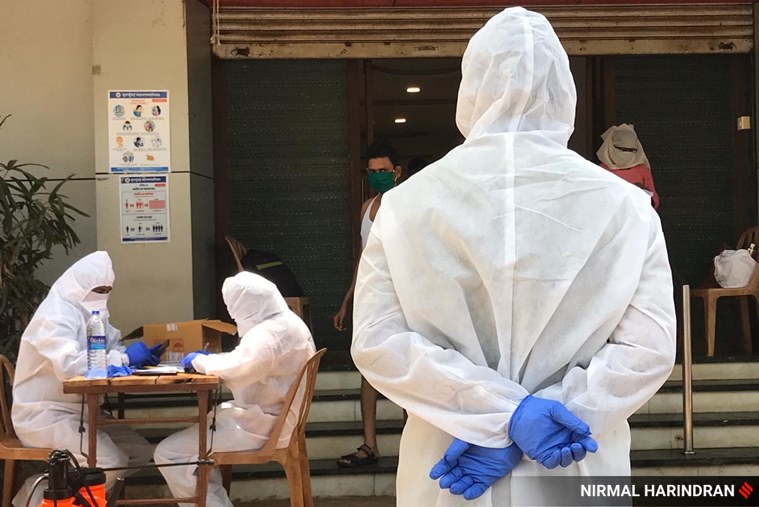 The hazmat suit is meant to ensure that no external particle, even air, goes through the suit and comes in contact with the body of the person wearing it.
The hazmat suit is meant to ensure that no external particle, even air, goes through the suit and comes in contact with the body of the person wearing it.
AFTER SPENDING his first night shift at the COVID-19 ward of PGIMER, nursing officer Narendra Tyagi gulped down his first breath of fresh air at 2 am. His verdict after his first experience using a PPE (Personal Protective Equipment) kit? He felt suffocated, unable to breathe or move normally. “After my shift ended, I left the building and walked around trying to get as much air in my lungs as possible,” says Tyagi.
Though he panicked at the start, thinking he had developed the most distressing symptom of COVID-19 — difficulty in breathing — he later realized it was just the after-effect of wearing a hazmat suit for eight hours at a stretch for the first time in his life.
The PPE has become a household term since the pandemic began. Though at first, one only knew of the plight of healthcare workers who did not have access to protective wear, one is now hearing about with the plight of workers who have to spend hours in the three-layered plastic suit. “More than physical discomfort, it is can be mentally harrowing. It makes you feel claustrophobic, so if once the thought is in your head that you need to get out, you can’t stay inside anymore, you want to rip it off,” says Tyagi, who now has marks on his face from the two layers of masks he tightly straps on every night.
How the suit is worn
The hazmat suit is meant to ensure that no external particle, even air, goes through the suit and comes in contact with the body of the person wearing it. Since scientists and doctors realised that COVID-19 spreads through droplets as well as aerosol particles, a completely sealed hazmat suit has become a must for healthcare workers. At PGIMER as well, no risks are taken when it comes to donning the suit properly.
“Each layer has to be worn in the right manner and completely sealed, otherwise there is no point,” explains Tyagi, who volunteered for COVID-19 duty and has been in the ward since April 29. At PGIMER, healthcare workers enter the Nehru Extension block where COVID-19 patients are hospitalized through a common donning unit. They remove their personal clothing and get into the usual scrubs which consists of a gown, shoe cover and the first layer of gloves. The gloves have to be fitted to the hand and the same goes for shoe covers, which are taped on to ensure there is no space between body and cover.
After the first layer of clothing, the healthcare workers put on the second layer which is a zipped overall. “The overall is zipped to your neck and even the zip is covered to ensure it is not exposed to virus,” says Tyagi. After donning the second layer, the nursing officer puts on another longer shoe cover, two layers of masks including the N 95 and a surgical mask over it, and goggles. “We ensure that the surgical cap covers our ears and hair and then we put on the hood of the overall tightly over these layers,” adds Tyagi.
After all this is over, healthcare workers wear another long sleeved gown and tape it in place to seal in the final layer. “When we reach our ward, we can put on a face shield whenever we feel it is necessary,” says Tyagi. Though the nursing officer personally believes that two layers of masks are enough protection, he and others have to wear the shield when in close proximity with patients. “For example, one patient complained of a tooth ache and I had to lean in close to check his teeth so I wore the shield,” added Tyagi.
Can’t go to the toilet
While wearing the three-layered sealed suit, one cannot use the toilet as the suit can only be taken off in the doffing unit for PPE disposal. Hence healthcare workers have to be careful not to hydrate too much. For Tyagi and others like him, it is a challenging combination of ordeals that they just have to get through. “If you don’t overthink it, one might get used to it, and you will figure out just how much to hydrate before your duty hours,” says Tyagi.
To add to these extremely uncomfortable circumstances, air conditioning cannot be used in the COVID-19 ward for fear of spreading the aerosol particles outside the hospital through the exhaust of the AC. Patients and medical staff have to make do with ceiling and table fans, even as we inch closer to the thick of an Indian summer.
Removing the suit
Tyagi’s duty finally ends in the doffing unit, where its most crucial for healthcare workers to remove each layer of the hazmat suit in a correct sequence so as to not expose themselves to the virus. Since most staff members are so frazzled and exhausted by the end of their duty hours, they have a hard time remembering the correct sequence, hence junior staff members regulate this particular exercise through a CCTV camera installed in the unit, reminding staff of the steps to follow while removing the suit.
“By the end of that you just want to get out of there so soon, because the whole duty is so stressful. These are hard times, but we have to play our part regardless,” says Tyagi.